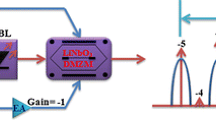Abstract
This study presents a hybrid analog/digital (A/D) mechanism of two-dimensional (2-D) structure of wavelength-hopping and time-spreading coding optical code-division multiple-access (OCDMA) system for future generation communication and network technologies. The 2-D method increases the maximum permissible number of simultaneous base stations (BSs) and security using a finite bandwidth of optical broad-band light source (BLS). In the proposed system, we can employ low-cost BLS which can mitigate the sampling rate of optical switch (OSW) and has the advantage of power saving. The performance enhancement is using the time-spreading method by a Mach-Zehnder modulator (MZM) with switch function to suppress the phase-induced intensity noise (PIIN) effect of the wavelength domain and the receiver structure is equipped with balanced detectors in order to suppress the multiple-access interference (MAI). In addition, the hybrid OCDMA network is equipped using a dual input MZM for the choice which time analog or digital signals to be transmitted and the advantage of these two kinds of signals can transmit by the same coder/decoder (codec) mechanism and recover by different type filters in the receiver end. The numerical evaluation results demonstrate that, for analog and digital signals under PIIN- and MAI-limited conditions, the proposed system outperforms a conventional multi-wavelength and time-spreading OCDMA scheme. Hence, enhancing the confidentiality of the asynchronous networks of codeword assignments and integratable hardware designs for the scheme with a MZM, an optical switch (OSW), arrayed-waveguide grating (AWG) and fiber Bragg gratings (FBGs) in hybrid A/D 2-D OCDMA system is proposed.









Similar content being viewed by others
References
Way WI (1993) Optical fiber based microcellular systems: an overview. IEICE Trans Commun E 76-B(9):1091–1101
Wu JS, Wu J, Tsao HW (1998) A radio-over-fiber network for microcellular system application. IEEE Trans Veh Technol 47(1):84–94
Al-Raweshidy H, Komaki S (2002) Radio over fiber technologies for mobile communication networks. Artech House, Boston
Tsukamoto K, Higashino T, Nakanishi T, Komaki S (2003) Direct optical switching code-division multiple-access system for fiber-optic radio highway networks. IEEE/OSA J Lightwave Technol 21(12):3209–3220
Park S, Tsukamoto K, Komaki S (1998) Polarity-reversing type photonic receiving scheme for optical CDMA signal in radio highway. IEICE Trans Electron E 81-C(3):462–467
Hongli L, Shyu M-L (2011) Quality of service provision in mobile multimedia—a survey. Hum-Cent Comput Inf Sci 1(5):1–15
Hua Ho A, Ho YH, Hua KA, Villafane R, Chao H-C (2010) An efficient broadcast technique for vehicular networks. J Inf Process Syst 7(2):221–240
Pinaki S, Amrita S (2011) Security enhanced communication in wireless sensor networks using Reed-Muller codes and partially balanced incomplete block designs. J Converg 2(1):23–30
Kwong WC, Yang GC, Chang CY (2005) Wavelength-hopping time-spreading optical CDMA with bipolar codes. IEEE/OSA J Lightwave Technol 23(1):260–267
Yu K, Shin J, Park N (2000) Wavelength-time spreading optical CDMA system using wavelength multiplexers and mirrored fiber delay lines. IEEE Photonics Technol Lett 12(9):1278–1280
Wang Z, Chang J, Prucnal PR (2002) Theoretical analysis and experimental investigation on the confidentiality of 2-d incoherent optical CDMA system. IEEE/OSA J Lightwave Technol 28(12):1761–1769
Yang CC, Huang JF (2003) Two-dimensional M-matrices coding in spatial/frequency optical CDMA networks. IEEE Photonics Technol Lett 15(1):168–170
Yeh B-C, Lin C-H, Wu J (2010) Noncoherent spectral/spatial OCDMA system using two-dimensional hybrid codes. IEEE/OSA J Opt Commun Netw 2(9):653–661
Yen C-T, Huang J-F (2009) Realization of OSW/AWG-based bipolar wavelength-time optical CDMA for wired-wireless transmissions. Opt Fiber Technol 15(1):74–82
Smith EDJ, Blaikie RJ, Taylor DP (1998) Performance enhancement of spectral-amplitude-coding optical CDMA using pulse-position modulation. IEEE Trans Commun 46(9):1176–1185
Wei Z, Shalaby HMH, Ghafouri-Shiraz H (2001) Modified quadratic congruence codes for fiber bragg-grating-based spectral-amplitude-coding optical CDMA systems. IEEE/OSA J Lightwave Technol 19(9):1274–1281
Harada H, Kajiya S, Tsukamoto K, Komaki S (1995) TDM intercell connection fiber-optic bus link for personal radio communication systems. IEICE Trans Commun E 78-B(9):1287–1294
Kohlenberg A (1953) Exact interpolation of band-limited functions. J Appl Phys 12(12):1432–1436
Author information
Authors and Affiliations
Corresponding author
Rights and permissions
About this article
Cite this article
Yen, CT., Cheng, HC. & Ding, IJ. Hybrid analog/digital wavelength-time optical CDMA systems in radio-over-fiber transmissions. J Supercomput 69, 1139–1153 (2014). https://doi.org/10.1007/s11227-013-0964-1
Published:
Issue Date:
DOI: https://doi.org/10.1007/s11227-013-0964-1




